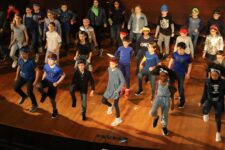Elijah M. ’31 tears down the path, a blur of arms and legs. His dad cheers him on as another class parent hollers, “Come on, Elijah!”
It’s the ECS-a-thon, the annual Ethical Culture event in which students in 1st–5th Grade run laps around the baseball diamonds in Central Park, and the enthusiasm is infectious. Parents and P.E. teachers yell out their praise as students sprint or jog past. Several Fieldston Middle students — who have the day off because of parent conferences — have returned to Ethical Culture to cheer on younger siblings. Today, the temperature feels more winter than autumn — it’s perhaps the coldest ECS-a-thon in history — but none of the children or cheering squad seem to have noticed; everyone’s eager for the run. As our students round bend after bend, they look forward to what every marathon runner looks forward to: the sense of pride, and the hoots and hollers of dozens of adoring fans.
In 2007, the Ethical Culture Physical Education team sought to revamp its curriculum to make running more enjoyable — thus was born the ECS-a-thon. Just like the New York City Marathon, the route takes students through all five boroughs of New York City — in this case, bases spaced out across the running path. Students are assigned to one of the five boroughs, where they start and end their run.
There’s a clever pedagogical reason for this arrangement: by spreading students out across different start points, the P.E. teachers hope to avoid giving students the impression they are directly competing with their peers. Karen Strock, member of the P.E. team, says: “It’s less about a race format; it’s more about your personal best.”
To offset the loneliness and monotony that can sometimes set in during a run, students are encouraged to choose running buddies. These buddies may not be their closest friends, but they match their speed and can help them keep pace. Chris Viven, Associate Teacher in the P.E. department, says that “the kids who aren’t as invested in running, they still try to share with each other, ‘oh, I walked one lap, I ran two laps.’”
As successful as the ECS-a-thon already is, the P.E. team continues to add modifications to make each successive iteration a better learning experience for students. “This year was a shift in goal-setting,” says Clare Svedlow, P.E. Teacher. Whereas in years past the teachers determined the number of laps students in each grade should run, this year, they’ve only given students a range, allowing them to decide on a target number for themselves. The effect has been overwhelmingly positive.
It’s less about a race format; it’s more about your personal best.
“They’ve actually given more effort now that we’ve switched it to goal-setting,” says P.E. Teacher Kelton Cumberbatch.
Another adjustment is how the ECS-a-thon starts. Past runs began with the blowing of a whistle. The P.E. team noticed, however, that the build-up to the whistle was causing some children to feel anxious. As a result, teachers now allow students to start whenever they’re ready.
This level of responsiveness is indicative of how strongly the faculty believe a positive experience in gym class can inspire a student’s love for physical activity. Not everyone intends to be an athlete, nor is that the goal of the P.E. teachers. Instead, the focus of the department is on developing life skills, “this idea of, ‘it’s bigger than P.E.,’ exposing them to a variety of things that they can hopefully do for the rest of their lives,” says Cumberbatch.
Two 1st Graders are coming down the final stretch. As they pass home base, Strock cries out, “Great pace! I’m so proud of you.” There’s high-fives and hugs all around; even the leaves fall through the air like confetti, celebrating our students’ achievement. In a clearing just across from Ethical Culture, the whole class gathers for a group photo to commemorate their first ECS-a-thon — the first of many to come.














